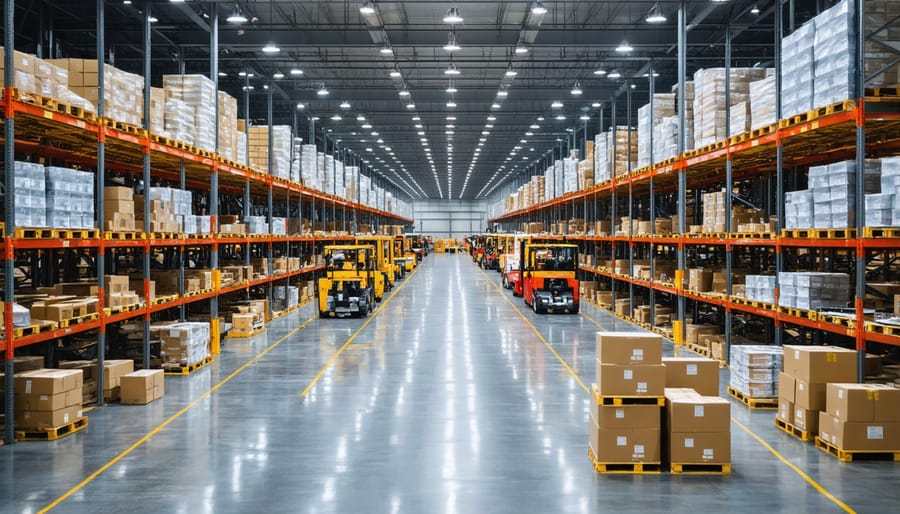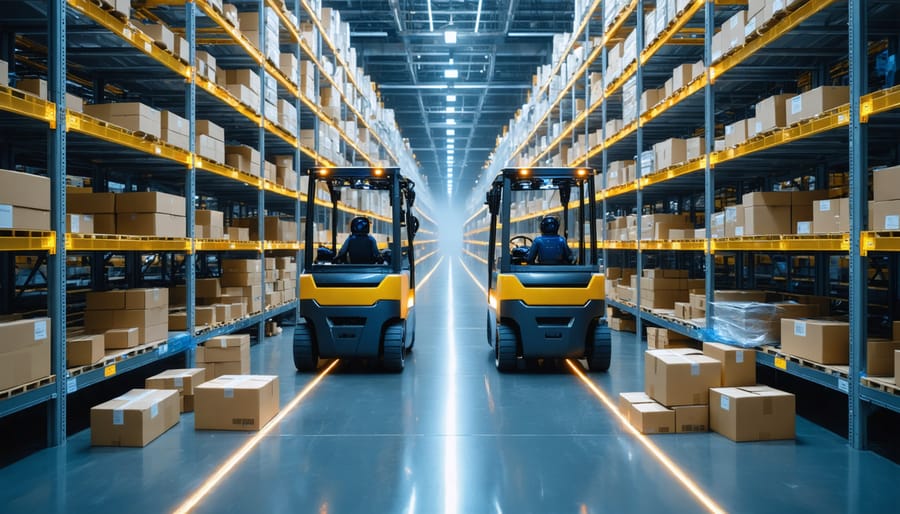Imagine ordering a product online and receiving it the next day—perfectly timed, efficiently routed, and at the lowest possible cost. Behind this seamless experience lies a revolution in how companies manage their supply chains, powered by machine learning algorithms that process millions of data points in seconds.
Machine learning is transforming supply chain management from reactive guesswork into proactive precision. Traditional supply chains relied on historical patterns and human intuition, often leading to overstocked warehouses, delayed shipments, and missed opportunities. Today’s AI in supply chains predict demand fluctuations before they happen, optimize delivery routes in real-time, and identify potential disruptions weeks in advance.
The impact is staggering. Companies implementing machine learning supply chain optimization report 15-30% reductions in inventory costs, 65% fewer stockouts, and dramatic improvements in delivery accuracy. Amazon uses ML algorithms to predict what you’ll buy and position products closer to your location before you even click “purchase.” Walmart leverages predictive analytics to manage inventory across 11,000 stores, while DHL optimizes delivery routes for thousands of vehicles simultaneously.
But this isn’t just about tech giants with unlimited resources. Machine learning tools have become increasingly accessible, allowing businesses of all sizes to harness predictive power that was impossible just five years ago. Whether you’re a professional evaluating ML implementation for your organization or simply curious about how artificial intelligence reshapes our daily lives, understanding supply chain optimization offers a window into AI’s most practical and impactful applications.
This guide breaks down the complex world of machine learning supply chains into clear, actionable insights—no advanced degree required.
What Machine Learning Brings to Supply Chain Management

The Data Advantage
Modern supply chains generate an overwhelming tsunami of data every single day. Consider this: a mid-sized retailer might track inventory across hundreds of locations, monitor thousands of products, process weather forecasts for dozens of regions, analyze social media trends, and follow real-time shipping updates from multiple carriers. For a human analyst, making sense of even a fraction of this information would take weeks—by which time the data would be obsolete.
This is where machine learning truly shines. ML algorithms can simultaneously process millions of data points from diverse sources that would be impossible to handle manually. Think of weather patterns affecting harvest yields in agricultural supply chains, sudden shifts in consumer behavior during trending social events, or unexpected port delays rippling through global shipping networks.
For example, an ML system can connect seemingly unrelated dots: detecting that a tropical storm forming in the Pacific Ocean might delay container ships, while simultaneously noticing increased online chatter about a product category, then automatically adjusting inventory distribution to alternate warehouses. This level of multi-variable analysis happens in seconds, not days.
AI-powered analytics transforms this data deluge from an overwhelming challenge into a competitive advantage. The system continuously learns patterns from historical data—like how winter weather typically impacts delivery routes or how promotional campaigns affect demand—and applies these insights to make increasingly accurate predictions. What once required teams of analysts working around the clock now happens automatically, allowing human experts to focus on strategic decisions rather than data crunching.
Prediction vs. Reaction
Traditional supply chain management operates much like a game of whack-a-mole—problems pop up, and teams scramble to fix them. A shipment gets delayed? Rush to find alternatives. A supplier runs short? Frantically search for backup options. This reactive approach keeps organizations perpetually one step behind, fighting fires rather than preventing them.
Machine learning flips this script entirely by enabling predictive capabilities that spot trouble on the horizon before it arrives.
Imagine a clothing retailer preparing for the holiday season. In the traditional reactive model, they’d order inventory based on last year’s sales and hope for the best. If a popular item sells out, customers face disappointment and the company loses revenue. If they overstock, excess inventory sits in warehouses, tying up capital.
Now consider the ML-powered approach: The system analyzes years of sales data, weather patterns, social media trends, economic indicators, and even local events. It notices that unseasonably warm weather typically reduces winter coat sales by 30%, or that certain styles trending on social platforms drive unexpected demand spikes. The system then predicts what will sell, where, and when—adjusting orders accordingly weeks in advance.
When severe weather threatens a key shipping route, ML models detect the pattern early and automatically reroute shipments through alternative channels before delays occur. The difference? Instead of reacting to problems, you’re preventing them altogether.
Real Problems Machine Learning Solves in Supply Chains
Demand Forecasting That Actually Works
Traditional demand forecasting often relies on spreadsheets and gut feelings, leading to costly overstock or frustrating stockouts. Machine learning transforms this guesswork into science by analyzing patterns humans might miss entirely.
ML algorithms digest years of historical sales data, automatically identifying seasonality patterns, growth trends, and cyclical behaviors. But they go further—incorporating external factors like weather conditions, economic indicators, social media sentiment, and even local events that influence purchasing decisions. The system continuously learns and adjusts, becoming more accurate with each prediction cycle.
**A Real-World Example**
Consider a beverage company that traditionally ordered inventory based on last year’s sales plus a safety buffer. Their ML system now processes five years of sales history, regional weather forecasts, upcoming sports events, and promotional calendars. When predicting demand for a summer weekend, the algorithm notices that temperatures above 85°F near major stadiums correlate with 40% higher sales.
The result? The company reduced waste from overstocking by 23% while simultaneously cutting stockouts by 31%. Previously, their spreadsheet model might have predicted 10,000 units for that weekend—the ML system recommended 13,200 units based on the weather-event combination, and actual sales reached 13,050.
This level of precision helps businesses optimize inventory investments, reduce storage costs, and most importantly, ensure products are available exactly when and where customers want them.
Inventory Optimization Without the Guesswork
Finding the sweet spot between having too much inventory gathering dust and too little stock to meet customer demand has always been a retail headache. Machine learning algorithms solve this balancing act by analyzing patterns humans simply can’t process at scale.
Here’s how it works: ML models examine historical sales data, seasonal trends, local market preferences, and even external factors like weather patterns or upcoming events. For a clothing retailer, the system might recognize that winter coats sell faster in Minneapolis than Miami—an obvious insight. But it also detects subtler patterns, like how rainy forecasts increase umbrella sales by 23% in specific neighborhoods, or how certain product combinations frequently sell together.
The real magic happens when the system optimizes inventory across multiple warehouse locations simultaneously. Instead of each store manager guessing their needs, the algorithm calculates precise stock levels for every product at every location. It considers shipping times between warehouses, regional demand variations, and supplier lead times.
One grocery chain using ML inventory optimization reduced food waste by 30% while simultaneously cutting stockouts in half. The system learned that avocados need replenishment three days before predicted demand spikes—not when shelves empty. This predictive approach means products arrive exactly when needed, reducing storage costs while keeping customers happy.

Route Planning That Adapts in Real-Time
Getting packages from warehouse to doorstep involves countless variables that change by the minute. Machine learning excels at solving this puzzle through intelligent route planning that adapts on the fly.
Traditional routing systems plot fixed paths at the start of each day, but ML algorithms continuously process real-time data streams to optimize delivery routes dynamically. These systems analyze current traffic patterns, weather conditions, road closures, and accident reports, then instantly recalculate the fastest path for each vehicle.
Consider a delivery driver starting their morning route. As they progress, the ML system monitors their actual location against predicted timings. If unexpected traffic congestion appears ahead, the algorithm immediately reroutes the driver around the delay while simultaneously reordering their remaining stops to maintain delivery windows.
The system also factors in vehicle-specific constraints like cargo capacity, fuel efficiency, and driver hours. When a customer requests a last-minute delivery, the algorithm identifies which vehicle can accommodate the package with minimal disruption to existing routes.
Companies like UPS have saved millions of gallons of fuel using ML-powered route optimization, while simultaneously improving on-time delivery rates. The system learns from historical patterns too—understanding that certain neighborhoods experience predictable rush hours or that specific weather conditions typically slow certain routes, making future predictions even more accurate.
Spotting Disruptions Before They Cascade
Machine learning acts as an early warning system for your supply chain, detecting subtle signals that humans might miss until it’s too late. By analyzing historical data from thousands of shipments, weather patterns, supplier performance records, and even social media trends, ML algorithms can spot correlations that predict disruptions days or weeks in advance.
For example, if a supplier’s delivery times gradually increase by just 5-10% over several weeks, ML systems flag this as a potential bottleneck before it impacts production. Similarly, algorithms can identify quality issues by recognizing patterns in defect rates, raw material sources, or manufacturing conditions that precede product failures.
Consider a food manufacturer that implemented ML monitoring across its ingredient suppliers. The system detected an unusual pattern: delayed shipments consistently occurred when a specific trucking company was involved. Armed with this insight, the company rerouted shipments and avoided what would have been a costly production halt.
This proactive approach transforms supply chain management from reactive firefighting to strategic prevention, allowing teams to explore alternative suppliers, adjust inventory levels, or modify production schedules before small hiccups become major crises.
The Machine Learning Models Powering These Solutions
Neural Networks for Complex Pattern Recognition
Neural networks process supply chain data much like your brain learns to recognize a friend’s face in a crowd. Initially, the network knows nothing—but through exposure to thousands of examples, it begins identifying patterns invisible to traditional algorithms.
Think of a neural network as layers of decision-makers, each examining different aspects of your supply chain data. The first layer might notice simple patterns like seasonal demand spikes. Deeper layers combine these observations, recognizing complex relationships—perhaps that rainy weather in one region, combined with a holiday approaching and specific social media trends, predicts a 30% inventory increase needed at certain warehouses.
What makes deep learning particularly powerful for supply chains is its ability to simultaneously process multidimensional data: weather patterns, economic indicators, social media sentiment, transportation schedules, and historical sales—all at once. Traditional systems struggle when variables exceed a handful; neural networks thrive on complexity.
During training, the network makes predictions, receives feedback on accuracy, and adjusts its internal connections—essentially learning from mistakes. Over time, it develops an intuitive understanding of your supply chain’s behavior, identifying opportunities and risks that even experienced managers might miss. This capability proves invaluable when managing global networks where hundreds of variables interact simultaneously.
Time Series Models for Forecasting Trends
Time series models excel at understanding patterns that unfold over time—perfect for supply chain forecasting where history often repeats itself. Think of these models as analyzing the story your data tells across days, weeks, and seasons.
**ARIMA** (AutoRegressive Integrated Moving Average) works like a mathematical detective, examining past trends and cycles to predict what comes next. It’s particularly effective for stable, predictable patterns like weekly grocery sales or monthly production needs.
**LSTM** (Long Short-Term Memory) networks take a more sophisticated approach. These neural networks remember both recent and distant events, making them ideal for complex scenarios. Imagine predicting smartphone demand during a product launch while considering last year’s holiday season and recent competitor announcements—LSTMs handle these layered influences naturally.
For example, a beverage company might use LSTM to forecast demand by analyzing historical sales, weather patterns, local events, and promotional campaigns simultaneously. The model learns that ice cream sales spike during summer festivals, helping optimize inventory weeks in advance.
These models don’t just predict numbers—they identify seasonal variations, detect emerging trends, and flag unusual market shifts, enabling supply chain managers to act proactively rather than reactively.
Reinforcement Learning for Decision-Making
Reinforcement learning (RL) takes a fundamentally different approach to supply chain optimization—it learns by doing. Instead of analyzing historical patterns, RL algorithms make decisions, observe the outcomes, and adjust their strategy based on rewards or penalties they receive. Think of it like training a dog: good decisions get treats, poor ones don’t, and over time, the algorithm learns what works best.
This trial-and-error methodology proves especially valuable for complex supply chain challenges. In inventory management, an RL system might experiment with different reorder points and quantities, learning to balance the competing goals of avoiding stockouts while minimizing holding costs. The algorithm discovers that ordering too early ties up capital, while ordering too late loses sales—eventually finding the optimal sweet spot through experience.
Routing problems benefit similarly. An RL agent can explore countless delivery route combinations, learning which strategies minimize fuel costs and delivery times under varying traffic conditions and customer demands. Unlike traditional optimization, RL adapts continuously as conditions change.
Major companies are already implementing RL systems. Warehouse robots use reinforcement learning to optimize picking routes, while logistics firms apply it to dynamic route planning that adjusts in real-time to delays or order changes. The power lies in RL’s ability to handle uncertainty and learn strategies that humans might never consider.
How Companies Are Actually Implementing This Technology
Retail Giants Reducing Waste
Major retailers are turning to machine learning to tackle one of their biggest challenges: food waste. Walmart, for instance, uses ML algorithms to predict demand for perishable items like fresh produce and dairy products with remarkable accuracy. By analyzing historical sales data, weather patterns, local events, and even social media trends, their system adjusts orders automatically to match actual customer needs.
Similarly, Kroger implemented an AI-powered platform called “Fresh Insights” that monitors real-time inventory levels and predicts when perishables are likely to spoil. The system recommends markdowns at optimal times—early enough to sell the product but late enough to maintain profit margins. This approach has helped reduce waste by up to 30% in pilot stores.
UK-based Tesco partnered with AI companies to develop predictive models that account for variables like promotional campaigns and seasonal fluctuations. Their machine learning system reduced food waste by millions of pounds while simultaneously improving product availability for customers. These real-world examples demonstrate how ML transforms abstract data into concrete actions that benefit both retailers’ bottom lines and environmental sustainability.


Manufacturing’s Predictive Maintenance Revolution
Imagine a factory where machines tell you they’re about to break down—before they actually do. That’s the power of predictive maintenance powered by machine learning, and it’s transforming how manufacturers operate.
Traditional maintenance follows a simple schedule: fix things at regular intervals or wait until they break. Both approaches waste money—either through unnecessary repairs or costly downtime. Machine learning changes this game entirely by analyzing patterns in equipment data to predict failures days or weeks in advance.
Here’s how it works: Sensors continuously monitor machinery, tracking vibrations, temperature, sound, and performance metrics. ML algorithms process this data stream, learning what “normal” looks like for each machine and detecting subtle anomalies that signal impending problems. When a bearing starts wearing out, the algorithm notices tiny changes in vibration patterns that human technicians might miss.
General Electric pioneered this approach with their wind turbines, using predictive maintenance to reduce downtime by 20% and extend equipment lifespan. Automobile manufacturers like BMW now predict production line failures with 92% accuracy, scheduling repairs during planned downtime rather than scrambling when machines stop unexpectedly.
The benefits extend beyond maintenance. These same ML systems optimize production scheduling by understanding each machine’s real-time capacity and reliability. If a critical machine shows early warning signs, the system automatically adjusts production schedules, rerouting work to healthy equipment and preventing bottlenecks before they form.
Getting Started: What You Need to Know
The Data Foundation
Think of machine learning as a chef creating a masterpiece—the quality of ingredients matters far more than quantity. In supply chain optimization, your ML models need the right data to make accurate predictions and smart decisions.
Essential data includes **historical order volumes**, shipping times, inventory levels, supplier performance metrics, and seasonal demand patterns. Weather data, economic indicators, and even social media trends can add valuable context. The key is collecting information that directly influences your supply chain outcomes.
Start by auditing your existing systems—your warehouse management software, transportation platforms, and order processing systems already generate valuable data. Install IoT sensors to track real-time conditions like temperature during transit or stock levels on shelves. Integrate data from suppliers and logistics partners to get a complete picture.
Here’s the critical point: **clean, accurate data from three months outperforms messy data from three years**. Before feeding information into your ML models, remove duplicates, fix inconsistencies, and fill gaps. A single incorrect data point—like a misrecorded delivery time—can skew predictions across your entire network. Quality control isn’t glamorous, but it’s the foundation that determines whether your machine learning project succeeds or fails.
Tools and Platforms Available Today
The good news? You don’t need to build ML solutions from scratch. Today’s landscape offers diverse tools suited for different needs and budgets.
**Enterprise platforms** like SAP Integrated Business Planning and Oracle Cloud SCM provide comprehensive, ready-to-deploy solutions with ML capabilities built in. These handle everything from demand forecasting to inventory optimization, ideal for large organizations seeking turnkey systems with vendor support.
For mid-sized companies, **specialized ML platforms** such as Blue Yonder, Llamasoft, and Kinaxis combine supply chain expertise with machine learning, offering focused solutions for specific challenges like route optimization or warehouse management.
**Cloud-based options** from Amazon (AWS Forecast), Microsoft (Azure Machine Learning), and Google (Vertex AI) provide flexible, scalable environments where you can build custom solutions using pre-trained models and industry templates. These balance customization with accessibility, requiring moderate technical expertise.
For those starting small or exploring possibilities, **open-source tools** like Python’s scikit-learn, TensorFlow, and Prophet forecasting library offer powerful capabilities at no cost. Many companies begin experimenting with these before scaling to enterprise solutions.
The key is matching the tool to your organization’s size, technical capacity, and specific supply chain challenges rather than chasing the most advanced platform.
Skills Your Team Will Need
Building a machine learning supply chain team doesn’t require everyone to become data scientists overnight. Start with your existing supply chain experts—they already understand the business problems. Pair them with data analysts who can wrangle spreadsheets and databases. You’ll need one or two ML specialists to build models, but even junior practitioners can start with pre-built tools.
The realistic timeline? Basic forecasting models can be operational in 3-6 months with focused team skills development. Your domain experts will need foundational training in data literacy—understanding what clean data looks like and how algorithms make decisions. Meanwhile, technical staff must learn supply chain fundamentals: lead times, seasonal patterns, and inventory costs.
Most companies succeed by starting small: one use case, manageable scope, and clear success metrics before expanding their capabilities.
The Challenges Nobody Talks About
When ML Gets It Wrong
Machine learning isn’t infallible—it learns from historical patterns, which means it can stumble when faced with unprecedented situations. Consider the pandemic’s impact: ML models trained on years of stable demand data suddenly faced empty shelves and shipping chaos they’d never “seen” before. Their predictions became unreliable because the rules of the game had changed overnight.
Weather disasters, geopolitical conflicts, or viral social media trends can similarly throw algorithms off course. A fashion retailer’s ML system might confidently predict demand based on past seasons, completely missing that an influencer just made their competitor’s product go viral.
This is why human oversight remains non-negotiable. Supply chain managers bring contextual awareness that algorithms lack—understanding market sentiment, recognizing emerging risks, and making judgment calls when data alone isn’t enough. The most successful companies treat ML as a powerful assistant, not an autopilot, combining algorithmic precision with human intuition and experience.
The Integration Headache
Even with compelling benefits, implementing machine learning in supply chains isn’t straightforward. Most organizations operate on legacy systems—some decades old—that weren’t designed to communicate with modern AI tools. These established warehouse management systems, transportation platforms, and enterprise resource planning software often use different data formats and programming languages.
The challenge extends beyond technology. Supply chain teams accustomed to traditional forecasting methods may resist algorithmic recommendations they don’t fully understand. Data often lives in isolated silos across departments, making it difficult to feed ML models the comprehensive information they need. Integration requires careful planning around organizational AI integration, including change management strategies and cross-functional collaboration.
Real-world example: A major retailer spent eighteen months connecting their ML forecasting system to existing inventory software, requiring custom APIs and substantial data cleanup. The technical hurdles were significant, but the human element—training staff and building trust in the system—proved equally demanding.
Machine learning is fundamentally reshaping how supply chains operate, moving them from reactive systems to intelligent, self-optimizing networks. We’ve explored how ML algorithms can predict demand fluctuations, streamline warehouse operations, optimize delivery routes, and even anticipate equipment failures before they happen. The real magic lies not in replacing human decision-making, but in augmenting it—giving supply chain professionals powerful tools to navigate complexity with greater confidence and precision.
For organizations considering this transformation, the journey doesn’t require massive upfront investments or data science teams. Starting small with focused pilot projects—perhaps demand forecasting for a single product line or route optimization in one region—allows you to learn, iterate, and build momentum. The key is to begin experimenting with your existing data while gradually building the infrastructure and expertise needed for more sophisticated applications.
Looking ahead, several exciting trends are emerging on the horizon. Expect to see more integration of ML with Internet of Things sensors for real-time supply chain visibility, increased use of reinforcement learning for dynamic decision-making, and growing applications of natural language processing to streamline supplier communications. Sustainability optimization is another frontier where ML will play an increasingly vital role.
The supply chain landscape will continue evolving rapidly, but the fundamental principle remains constant: those who embrace these tools thoughtfully, learning as they go, will be best positioned to thrive in an increasingly complex global marketplace.

